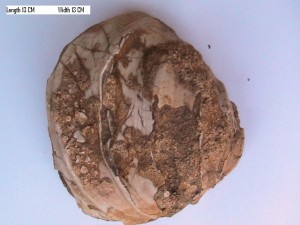
Inoceramus Fossil from Ariyalur/Dalmiapuram Copyright @ World Fossil Society (WFS),Riffin T Sajeev & Russel T Sajeev
Some species of clams (bivalves) grew to giant size in the late Cretaceous, attaining diameters of four feet or more. In cross section, these shells are composed of prismatic (calcitic) crystals. The inner, nacreous (Mother of Pearl) layer of the shell (composed of aragonite) was usually dissolved during fossilization and the outer portion is usually covered with colonies of oysters and other invertebrates. Pearls are occasionally found pressed into the Inoceramid shell. According to Sowerby 1823, Inoceramus means “fibrous shell,” describing the prisms that are visible on the edge of shell fragments. Inoceramus cuvieri was the first species of Inoceramus that was formally described by Sowerby (1814). Several species are found in the Late Cretaceous bed in Ariyalur and dalmiapuram in India. Fossil collectors Riffin T Sajeev and Russel T Sajeev have enough samples of the same from Ariyalur and Dalmiapuram formations.
As noted by Brown (1940) and Kauffman (1990), sometimes small round nodules are found attached to inoceramid shells. They are the remains of pearls that were fossilized along with the clam shell. The nacre or “mother of pearl” luster is not preserved in inoceramid pearls. This is because the pearly, nacreous color associated with true pearls is made up of a mineral called aragonite. Due to the environment Inoceramid shells and pearls have lost the thin inner pearly aragonite layer, and are solely composed of calcite. This also means that some kinds of shells, like those of ammonites, were not preserved because they are composed entirely of aragonite.
Phylum Mollusca Cuvier, 1795
Class Bivalvia Linné, 1758
The terminology follows that of the glossary in the Treatise on Invertebrate paleontology, part N.
Subclass Pteriomorphia Beurlen, 1944
Order Pterioida Newell, 1965
Suborder Pteriina Newell, 1965
Superfamily Ambonychiacea Miller, 1877
Family Inoceramidae Giebel, 1852
Genus Inoceramus J. Sowerby, 1814



 April 10th, 2015
April 10th, 2015  Riffin
Riffin  Posted in
Posted in  Tags:
Tags: 